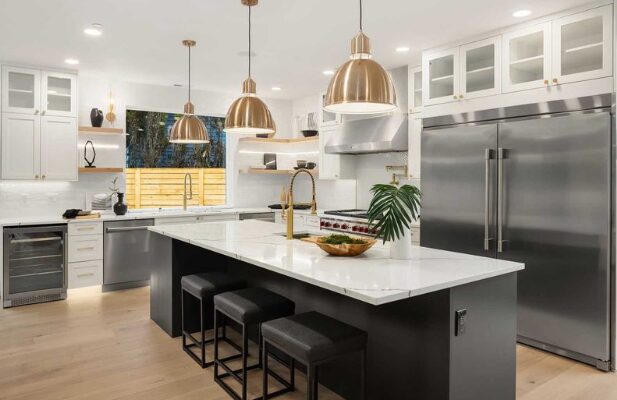Renovating an Older Home: Challenges and How to Overcome Them

Renovating an older home is a rewarding journey that can breathe new life into a space with historical charm. However, it also comes with unique challenges, from outdated wiring to hidden structural issues. Understanding these challenges and preparing for them can help you turn your renovation project into a seamless experience. Here, we’ll walk you through the most common obstacles in older home renovations and provide solutions to overcome them.
1. Outdated Electrical Systems
Older homes often come with outdated electrical wiring that may not meet current safety codes or support modern appliances. Homes built before the 1970s frequently have aluminum or knob-and-tube wiring, which can be dangerous if not properly maintained. Electrical issues can also contribute to overloaded circuits and increase the risk of electrical fires.
Solution: Electrical System Upgrade
- Hire a licensed electrician to inspect and, if necessary, rewire the entire house.
- Upgrade the electrical panel to support increased power demands.
- Install new outlets and circuits to safely accommodate modern devices.
- Tip: Always prioritize electrical work early in the renovation process, as it may require walls to be opened up.
2. Hidden Structural Issues
Homes that have been standing for decades may have hidden structural problems, such as foundation cracks, sagging floors, or deteriorating beams. These issues may not be apparent until walls or floors are opened up during renovation, potentially leading to unexpected delays and costs.
Solution: Structural Assessment and Reinforcement
- Before starting any major renovation, have a licensed contractor inspect the home to identify any underlying issues.
- Reinforce the foundation, replace compromised beams, and repair any structural damage.
- Set aside a portion of your budget for potential structural repairs, as these issues are often uncovered mid-renovation.
3. Hazardous Materials (Lead Paint and Asbestos)
Older homes often contain hazardous materials like lead paint and asbestos, which were widely used until health risks became known. Lead paint was common in homes built before 1978, and asbestos can be found in insulation, flooring, and siding. Both can pose health risks if disturbed during renovations.
Solution: Safe Removal and Abatement
- Hire a certified abatement professional to test for and remove hazardous materials safely.
- Follow local regulations and guidelines for handling lead and asbestos.
- Consider repainting or refinishing surfaces to encapsulate lead-based paint rather than removing it if removal isn’t feasible.
- Tip: Budget for abatement costs, as removing hazardous materials is often a necessary step in older home renovations.
4. Insufficient Insulation and Energy Efficiency
Older homes are often poorly insulated, leading to high energy bills and difficulty maintaining comfortable temperatures. Drafty windows, doors, and uninsulated walls can make older homes cold in winter and hot in summer, affecting both comfort and energy costs.
Solution: Improve Insulation and Energy Efficiency
- Upgrade insulation in walls, attic, and floors to modern standards.
- Replace old single-pane windows with energy-efficient double or triple-pane windows.
- Seal gaps around doors and windows to prevent drafts.
- Consider adding smart home technologies like programmable thermostats to further reduce energy costs.
5. Plumbing Problems and Leaks
Outdated plumbing systems in older homes can lead to frequent leaks, reduced water pressure, and even contamination risks if lead pipes are present. Over time, pipes can corrode, causing leaks behind walls or under floors, which can result in water damage.
Solution: Update the Plumbing System
- Inspect the entire plumbing system and replace any lead, galvanized, or corroded pipes with modern materials like PEX or copper.
- Upgrade fixtures like toilets, faucets, and showerheads to improve water efficiency.
- Waterproof critical areas, such as bathrooms and kitchens, to prevent future leaks.
- Tip: Combine plumbing updates with other renovations (such as bathroom or kitchen remodels) to save on labor costs.
6. Old and Outdated Floor Plans
Older homes often feature floor plans that are less open and may not meet modern lifestyle preferences. Rooms may be smaller, kitchens may be isolated, and storage space may be limited. Adjusting these floor plans can help create a more functional and appealing layout.
Solution: Open Up and Modernize the Floor Plan
- Remove non-load-bearing walls to create an open-concept design if desired.
- Repurpose unused spaces, like formal dining rooms, into functional areas such as home offices or playrooms.
- Add built-in storage solutions to maximize space in smaller rooms.
- Work with an experienced contractor or designer to reimagine the layout without compromising the structural integrity of the home.
7. Preserving Historical Details
Older homes often boast unique architectural features like ornate moldings, hardwood floors, and vintage fixtures. While preserving these elements adds character, restoring them can be challenging, especially if they are damaged or difficult to source.
Solution: Restore or Replicate Key Features
- Hire craftsmen or specialists skilled in historical restorations to repair or restore original elements.
- If original materials are too damaged, consider sourcing antique or reproduction pieces that match the home’s period style.
- Refinish hardwood floors rather than replacing them to retain the home’s original charm.
- Tip: Create a plan to blend restored elements with new finishes for a cohesive look that respects the home’s history.
8. Permit and Code Compliance
Renovating an older home often means bringing it up to current building codes, which can be complex and time-consuming. Many older homes are not compliant with modern safety standards, including electrical, plumbing, and structural codes. Getting permits and inspections can delay the renovation timeline but is essential for a safe remodel.
Solution: Work with Professionals for Permits and Compliance
- Consult with local authorities and obtain necessary permits before starting the renovation.
- Work with licensed professionals who understand building codes and can ensure compliance.
- Include time for permit approvals in your renovation timeline to avoid unexpected delays.
- Tip: Staying code-compliant will enhance the property’s value and provide peace of mind for future resale.
9. Budgeting for Unexpected Expenses
Renovations often come with unexpected expenses, but this is especially true with older homes, where hidden issues may arise. From structural surprises to additional labor costs for specialized work, it’s important to have a financial cushion.
Solution: Set a Contingency Budget
- Plan a contingency budget, typically 10–20% of the renovation budget, to cover unforeseen expenses.
- Prioritize critical repairs and allocate funds accordingly, addressing “must-fix” issues before cosmetic improvements.
- Regularly review expenses and adjust the budget as needed to keep the project on track.
Final Thoughts
Renovating an older home is a journey that requires patience, planning, and often a bit of problem-solving. While these homes present unique challenges, each obstacle offers an opportunity to modernize, customize, and enhance your home while preserving its character. By understanding common renovation issues and working with experienced professionals, you can turn an older home into a dream space that meets both contemporary needs and respects its historical roots.
Whether you’re addressing outdated wiring, dealing with hidden structural issues, or updating the floor plan, a well-planned renovation can breathe new life into an older home, combining the charm of the past with the comforts of the present.





